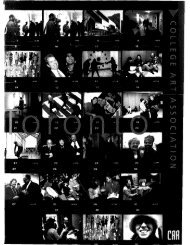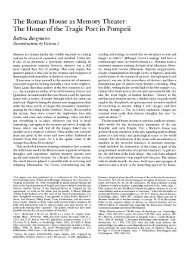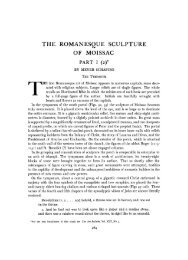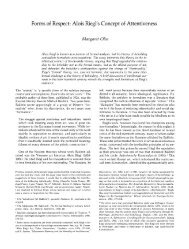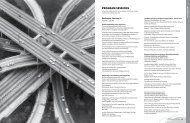THE HUMANISTIC THEORY OF PAINTING - College Art Association
THE HUMANISTIC THEORY OF PAINTING - College Art Association
THE HUMANISTIC THEORY OF PAINTING - College Art Association
Create successful ePaper yourself
Turn your PDF publications into a flip-book with our unique Google optimized e-Paper software.
UT PICTURA POESIS: <strong>HUMANISTIC</strong> <strong>THE</strong>ORY <strong>OF</strong> <strong>PAINTING</strong> 201<br />
treatises contained could not fail in a humanistic age to impress critics who sought to invest<br />
painting with the dignity of a liberal art, for Aristotle and Horace, not to mention fragmentary<br />
utterances of other ancient writers,21 had by implication already accorded her<br />
this dignity. And being in search of the doctrine that these ancient analogies seemed to<br />
imply, and finding it nowhere developed in antiquity,22 the critics did not limit their borrowings<br />
from the Poetics and the Ars poetica to those passages, after all few in number,<br />
in which painting and poetry are compared. Far more important, they did not hesitate to<br />
appropriate as the foundation of their own theory many basic concepts of the two ancient<br />
treatises, making them apply in a more or less Procrustean manner to the art of painting<br />
for which they were never intended. The theory of painting that resulted could not fail<br />
under such conditions to show much that was pedantic and absurd if it was not absolutely<br />
false, for in imposing on painting what was merely a reconditioned theory of poetry, the<br />
enthusiastic critics did not stop to ask whether an art with a different medium could<br />
reasonably submit to a borrowed aesthetic. And it was when the critics were occasionally<br />
independent enough to stray from the beaten path of antique doctrine and, instead of harping<br />
on the obvious likenesses of painting and poetry, attempted to analyze their differences<br />
or engaged in lively apology for one art or the other, that their remarks were often the<br />
most illuminating. Nevertheless the new Ars pictoria for all its defects was the child of the<br />
humanistic Renaissance, and contained much that was reasonable and true-much, indeed,<br />
that is so obviously true that even the sympathetic reader of sixteenth-century<br />
treatises is both vexed and amazed at the repetitious verbosity which attended the humanistic<br />
investiture of the art of painting. And the core of the new as of the ancient theorythat<br />
painting like poetry fulfils its highest function in a representative imitation of human<br />
life, not in its average but in its superior forms-is, notwithstanding its virtual eclipse at<br />
the present time, important and central to any final estimate of the painter's art.<br />
This humanistic doctrine had been more than implied, if never clearly defined, a century<br />
before the age of criticism began in Italy, in the writing of Leon Battista Alberti,23<br />
who, though unfamiliar with Aristotle's Poetics, knew that the painting of a "history"<br />
a significant human action-is the chief business of a serious painter, and had learned from<br />
Latin authors that the artists of antiquity had sought to bestow an ideal beauty upon their<br />
works. It appears later in the treatise of Leonardo,24 for if the experimental painter-scientist<br />
was largely unconcerned with inherited theory, he still could not fail to absorb some of it<br />
in the intellectual air of Florence; and Leonardo further shows the inalienable humanism<br />
of his race in his famous and often repeated statement that the expression of human emo-<br />
people who obviously set great store by the prestige afforded<br />
by antique models. See Appendix I, "On the Lack of<br />
Ancient Criticism of Painting."<br />
21. Plutarch, for instance, says that painters and poets<br />
represent the same subjects, and that the underlying purpose<br />
of both is the same (De gloria Atheniensium In. 347a);<br />
the elder Philostratus finds painting and poetry equally<br />
the repositories of wisdom (Imagines I. 294k); the younger<br />
Philostratus emphasizes the power of painting to express<br />
character and emotion and finds a certain element of imagination<br />
(4avracia) common to painting and dramatic<br />
poetry (Imagines, Procemium, 39ok).<br />
22. Pliny's famous account of painting in antiquity<br />
(Historia naturalis xxxv) upon which the sixteenth-century<br />
critics drew so heavily in their desire to proclaim the timehonored<br />
dignity of the art, although it occasionally adumbrates<br />
theories of art, is not a theoretical work.<br />
23. Della pittura, 1436. See the standard edition of<br />
Janitschek, L. B. Alberti's kleinere kunsttheoretische Schriften,<br />
Vienna, 1877, pp. 143 ff. Cf. Cicero De inventione 11. I,<br />
I; Orator ad Brutum 11. 7 ff., where the theory of ideal imitation<br />
has a strongly Platonic rather than Aristotelian<br />
character; Pliny op. cit. 62-64; notes 50o, 69, 74, 97. Aristotle's<br />
Poetics was not well known until the sixteenth century.<br />
The first reliable Latin translation, that of Giorgio<br />
Valla, appeared in 1498; the first commentary, Robortelli's,<br />
in 1548; the first Italian translation, Segni's, in 1549. Both<br />
Robortelli and Segni remark on the long neglect of the<br />
book. See J. E. Spingarn, A History of Literary Criticism<br />
in the Renaissance, 7th impression, New York, 1938, pp.<br />
16 ff.<br />
24. In his admonition to the painter "to be solitary and<br />
consider what he sees and discuss with himself, choosing<br />
the most excellent parts of the species of whatever he sees."<br />
"If he does this," Leonardo adds, "he will appear to be a<br />
second nature." See Trattato, I, 58a.



